|
|
Agonalis Obelisk
| Present Site: | Piazza Navona, Rome N 41°53'56.3"(41.898972) E 12°28'23.1"(12.473083) |
| Pharaoh: | Roman Emperor Domitian (Titus Flavius Domitianus, Latter half of 1st century) |
| Measurement: | 16.53 meters high for obelisk itself, 30.17 meters high including the pedestal |
| Stone: | Red granite |
About The Site:
This Agonalis Obelisk stands in the Piazza Navona, where is one of the most well-known tourists' spot, which is incorporated into the most sightseeing programs in Rome. Hence, here is always crowded by sightseers.
This Piazza was made based on the venues for chariot races, Circus Agonalis, which was constructed in AD 86 by Roman Emperor Domitian. The Piazza is still surround by the elliptically-shaped curb which shows the signs of ancient Circus.
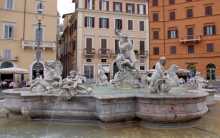 Fountain of Neptune, Rome
Fountain of Neptune, Rome
|
In this Piazza, there is the artistic Fountain of the Four Rivers, Fountain of Neptune, and the Chiesa di Sant'Agnese in Agone which faces to the Piazza. By this reason, the Piazza became the sightseeing spot of Rome.
Among them, Fountain of the Four Rivers (Fontana dei Fiumi) is acclaimed as a masterpiece of Bernini. This Fountain consists of four fountains represented by personifications - The Danube (representing Europe), The Ganges River (representing Asia), The Nile River (representing Africa), The Rio della Plata (representing Americas), and the obelisk stands at the center of them.
There are four obelisks on the way from the Piazza Navona, through Pantheon, to the Trevi Fountain (Fontana di Trevi) or the Spanish Steps (Scalinata di Trinita dei Monti). This would be a recommended course by walk which can visit many sightseeing spots in Rome.
Starting at the Piazza Navona, then Palazzo Madama (House of the bicameral Italian Parliament), Via degli Staderari, Pantheon, Chiesa di Santa Maria Sopra Minerva, and the Piazza di Montecitorio. After seeing the Montecitorio Obelisk, go to and see the marble Column of Marcus Aurelius (Colonna di Marco Aurelio) and the Palazzo Chigi (residence of the Italian prime minister), then three choices; to look the next Shopping Mall (Galleria Alberto Sordi) , or to go to the Trevi Fountain for southeast direction, or to go to the Spanish Steps for northeast direction.
In the movie "Angels & Demons" (based on Dan Brown's novel of the same name), obelisk was one of theme of the story, a murder case happened in the Piazza Navona, the 4th candidate of Pope was killed and sunk in the Fountain of the Four Rivers. And the dove on the top of obelisk was looking toward the direction of the Castel Sant'Angelo where is the last case happens.
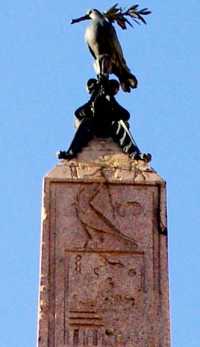 The pigeon on the top of obelisk
The pigeon on the top of obeliskis the family crest of pope clan. |
How To Get There:
There is no nearest Metro station for Piazza Navona. Although Barberini on Line "A" and Colosseo on Line "B" are comparatively closer, but we need to walk more than 1 km.
In the case to go here from Termini Station, using the Bus departing from the front square is convenient. If we take Bus #64 for Stazione San Pietro, and get off at Corso Vittorio Emanuele, then walk northeast direction about 100 meters. If we take Bus #70 for Clodio, and get off at Corso Rinascimento or Senato, then walk west direction about 50 meters. Bus #64 runs 8 timed per hour, and Bus #70 runs 4 - 6 timed per hour.
About The Obelisk:
The name of Agonalis Obelisk (Obelisco Agonalis) is derived from Circus Agonalis, as stated above. This obelisk is also called "Piazza Navona Obelisk", but I followed the expression of wikipedia "List of obelisks in Rome". It's 16.53 meters high, but 30.17 meters high in the case of including the sculptural pedestal of Four Rivers, therefore, this is highly visible symbol of this Piazza.
With the Bernini's great sculpture, this obelisk would be the most excellent one in the world. However, it's not Egyptian-made unfortunately. This was carried the red granite at upper Nile, by the order of Roman Emperor Domitian (Titus Flavius Domitianus, reigned AD 81 - 96), and was erected at the near of Iseum Temple (The temple for the Egyptian goddess Isis), the current site of the Chiesa di Santa Maria Sopra Minerva in Rome.
The picture at right enlarges the pyramidion (top triangle) of the obelisk. The Roman emperor is featured as a Egyptian pharaoh wearling the double crown and celebrated by two goddesses. This gives us an Egyptian style. The hieroglyph of esat side keeps in fine condition. This seems to express the throne succession story: "He [Domitian] hath [=has] received the Kingdom of his father, Vespasian, in the place of his brother, Titus the Great, after his soul flew up into heaven." (Source: E.A. Wallis Budge: Cleopatra's Needles and Other Egyptian Obelisks, The Religious Tract Society, London, 1926)
Domitian conflicted with Roman Senate, and considered a tyrant, was assassinated in 96. After he died, he received a judgment damnatio memoriae which erases all the records from history.
In 4th century, the obelisk was moved to the Circus of Maxentius (Circo di Massenzio) by Emperor Maxentius. He made this Circus for the memory of his son Romulus. It was along Ancient Appian Road (Via Appia Antica), 2.8 km south of Porta San Sebastiano, Rome, and the vast site still remains. Since Romulus passed away in around 309, and the Emperor passed away in 312, the obelisk is supposed to have transported to here between 309-312.
In around 6th century, the obelisk was toppled and broken into a few pieces. And it was left derelict at the ruins.
The famous Pope Sixtus V [reigned late 16th century] knew about this, but it was lower priority for restoration. In 1630s, British Earl of Arundel paid the deposit and attempted to transport those 4 pieces to London, but it was not permitted.
Then, finally in 17th Century, Pope Innocent X (Innocentius X) decided to re-erect it in Piazza Navona because he had lived in the building which faces the Piazza Navona. He planned to create a fountain, and put the obelisk on it in commemoration of his accession. An architect Giovanni Lorenzo Bernini who knew this plan, wanted to undertake this project, and aggressively appealed his design to the Pope. Then the appointment was made to him on April 11th, 1647.
The pieces of obelisk were assembled, and a Christian cross was replaced by the dove [a symbol of the Pope family], and put at the apex. The Four Rivers Fountain is known as one of Bernini's most celebrated works, and also one of typical masterpiece of the Baroque.
Although his memories and records were erased, but the obelisk inscribed his name, and was re-erected at the former site of Circus which was made by him, and is currently looked by most tourists visiting in Rome. It would be a kind of sarcasm in history.
The high cost of the project caused the tax increase, and resulted in loud protests against the Pope and his family. However, now this memorial is one of the most interesting spots in Rome.
Notes For Pictures:
Since here is one of the most interesting spots in Rome, many people are always in this Piazza. There are many coffee shops and restaurants around here, and the shops are extended into the Piazza with large parasols, particularly in summer time. So I took pictures in early morning around 7:30 before the visitors come to here in 2013. However, it was difficult due to against the sun which is lower elevation angle. Here are the pictures in 2014 when I re-visited here. Many tourists are around the obelisk.
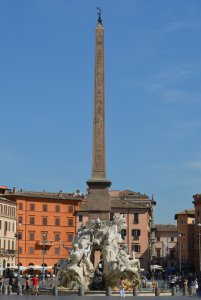 South Side |
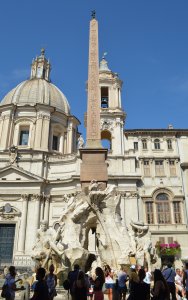 East Side |
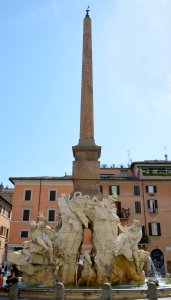 West Side |
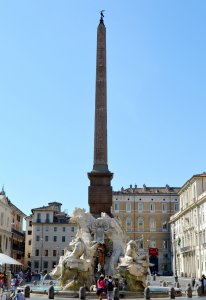 North Side |
|||
August 11, 2014 by Hiroyuki Nagase (For high definition image, please click the picture) | ||||||
Copyright Hiroyuki Nagase nagase@obelisks.org and Shoji Okamoto okamoto@obelisks.org